

Gig2Gether
Empower gig workers through data sharing and collective action while providing policymakers with crucial information to improve work conditions in the gig economy.
-
Team: 3 backend developers + me
-
Role: UX Researcher, Designer & Frontend Developer
-
Responsibilities:
-
Design (experience, Interface, system, & logo design)
-
Research (user recruitment, protocol, interview, usability testing, field study, data analysis)
-
Front-end development
-
-
Timeline: Jun. 2024 – Dec. 2024
Background & Summary
Empowering Gig Workers through Data-Sharing

Gig2Gether is a collaborative data-sharing app for gig workers to tackle data transparency, social isolation, and lack of support by sharing data to inform policies and improve work conditions.


Problems & Challenges
Unfair Pay, Safety Concerns & Lack of Legal Protection for Gig Workers

Unfair Pay and Exploitation
Gig workers receive low wages and face hidden fees and unpaid labor.
A pet walker noted, "Platforms take excessively high commissions (40%), including from tips."
Platforms use opaque algorithmic systems, making it difficult for workers to predict and track their income.
A rideshare driver explained, "No longer are we paid per minute [or] per mile...Now they give you an 'upfront price,' which is typically extremely, much, much lower than what the customer paid."
Safety and Discrimination
A particular burden is placed on marginalized communities.
A worker highlighted, "There’s a safety concern, and it feels like the onus of that safety is put entirely on the individual sitter."
The lack of protections leaves workers vulnerable to unsafe working conditions and client harassment.
A worker shared, "A friend who does services in the metro Atlanta area [had an experience] where there was an owner who had...undisclosed cameras, and he was asking specifically young women to do house sits."


Lack of Legal Protections
Gig workers are classified as independent contractors, which excludes them from many labor protections and benefits, such as minimum wage, unemployment insurance, and the right to unionize.
This classification allows platforms to "circumvent provisions of standard benefits and protections typically afforded to employers."
Design Requirements
Worker-Centered Data Sharing with Privacy and Cross-Platform Integration for Collective Advocacy and Policy Influence
DR 1
Center Worker Needs & Goals for Advancing Policy Initiatives
DR 1.1
Support Quantitative and Qualitative Data Sharing for Impacting Policy. [2] [10] [12] [13] [14] [24]
DR 1.2
Provide Trust via Privacy, Security, and Data Control. [4] [15] [5] [18] [10] [16]
DR 1.3
Support Heterogeneous Worker Goals and Workflows. [7] [10] [18] [23]
DR 2
Facilitate Worker Collaboration & Resource Sharing
DR 2.1
Encourage Contributions that Inform Key Labor Initiatives. [8] [10] [23] [18]
DR 2.2
Connecting Workers to Resources of Other Stakeholders. [7] [8] [18]
DR 2.3
Multi-Domain Support & Worker-Accessible Tools. [2] [10] [11] [17] [19]
DR 2.4
Empower Collectivism & Cross-Stakeholder Communication. [1] [3] [6] [8] [9] [20] [21] [22]
Gig workers can securely upload and track work data, compare trends, share stories, and optimize their tasks and earnings.
Built with SvelteKit and Firebase, it empowers users to plan gigs, monitor performance, and access vital tax and community resources.
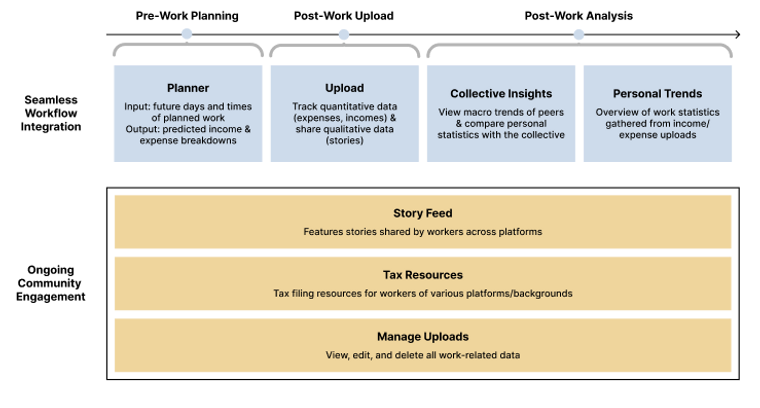
Overview of Features Available to Workers Before, After and Between Gigs
System Design
Secure Data Sharing, Trend Tracking, Work Optimization, and Community Connection
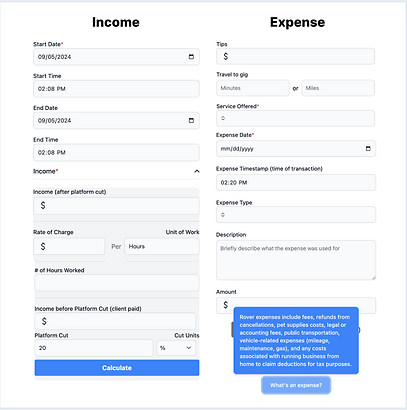
Upload Your Data: Upload gig work data through a secure system.
DR 1.1
DR 1.3
DR 2.3
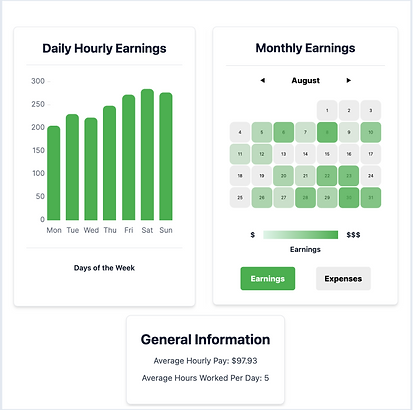
Explore Trends: Access personal trends to track performance.
DR 1.3
DR 2.3

View collective insights: Compare personal data with aggregated statistics and detailed breakdowns.
DR 1.3
DR 2.3
DR 2.4

Community Engagement: Connect with gig workers in the community. Exchange experiences, discuss issues, and share strategies to thrive in the gig economy.
DR 1
DR 2

Optimize with the Planner: Use the Planner to strategically choose work locations and times. Leverage historical data to improve earnings and efficiency.
DR 1.3
DR 2.3

Navigate Taxes with Ease: Manage tax obligations and maximize deductions. Leverage tools and resources for a smoother gig work journey.
DR 1.3
DR 2.3
Design & Development
Crafting and Conducting User Studies to Refine and Enhance the System Iteratively based on user feedback
Initial sketches: We created low-fidelity sketches to conceptualize the key features, guided by design requirements. We iteratively refined them through sketching sessions.
.png)
Early Sketches
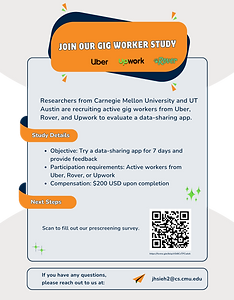
Recruitement Flyer
Recruitment: I created a flyer for participant recruitment and successfully recruited 20+ participants from subreddits and airports.
Iterative tests: I developed protocols and conducted two rounds of think-aloud sessions with 6 workers from different platforms, using feedback from these sessions to iteratively refine and implement the app features based on Figma mock-ups.

Mock-Up Examples

Participants Table
Onboarding Sessions: Another researcher and I led onboarding sessions with 16 participants, introducing Gig2Gether’s features, guiding them through 7-day tasks and compensation, and offering real-time feedback and study details.
Exit Interview: We conducted one-hour semi-structured exit interviews, focusing on key Gig2Gether features like data uploading, trend analysis, storytelling, and planning tools, while tailoring questions to participants' interactions.

Exit Intervew Questions

Descriptive Statistics
Analysis: We used a mixed-methods approach, combining quantitative analysis of usage data from the system backend with qualitative open coding of onboarding and exit interviews to explore workers' interactions with the app.
Findings & Insights
Empowering Workers via Finance Tracking, Collective Insights, Policy Advocacy, and User-Driven Features
Insight 1
Solidarity & Collectivism through Cross-Platform Story and Data Exchange
Workers appreciated Gig2Gether’s unique role in fostering a supportive community. Unlike forums that often feel disjointed or unhelpful:
“the subreddit is really just a lot of sharing . . . but not necessarily useful [content] . . . but [Gig2Gether] offers tools” (Freelancer-2).
“There’s a lot of things that I would like to share, but most of them are political. So, like: we should all get together, fight back against Uber . . . [but] I didn’t know how political I could be [on the Story feed].” (Driver-2)
Stories often sparked cross-platform curiosity. Workers liked stories from other domains similarly; they even reconsidered where they might work next:
“I did [like] one [story] from Upwork because I was actually looking to work there for Upwork at some point . . .I saw a lot of pointers that people gave for Upwork, and I was like, ‘You know what? I’m gonna definitely keep that in mind.’ ” (Petsitter-3)
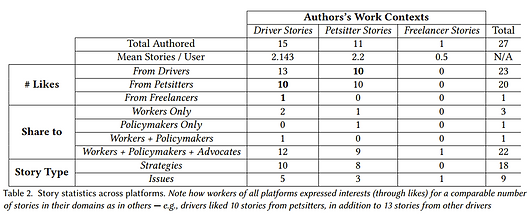
Story statistics across platforms
Insight 2
In-Depth Insights into Safety & Wage Concerns – 'A Door Between Workers and Politicians'
Participants saw Gig2Gether as a legitimate channel to advocate for improved working conditions, readily sharing data on safety hazards and wage deterioration with policymakers.
“Incidents...like physical assault, being disorderly, and causing damage to the driver’s vehicle (this happens pretty often), passengers getting arrested out of the back of your car”. (Driver-1)
“you’re going into somebody’s house, it’s a vulnerable position to provide work...sitters are background checked, clients are not”. (Petsitter-4)
For many of these rideshare drivers, gaining access to collective evidence is quintessential for exposing the rapid wage declines: “This data is important because we want to expose literally what we’re making. We want these policymakers to see this”.
Workers shared more strategies than issues, with “safety” and “fair pay” emerging as the most used tags.
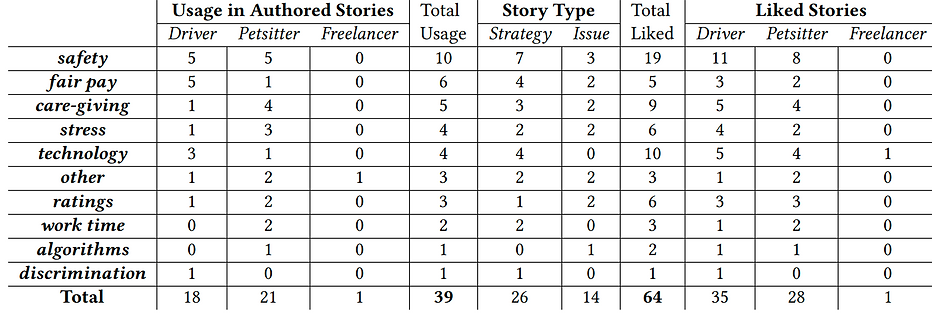
Tag Statistics Across Platforms
Insight 3
Workers Seek Expanded Metrics for Financial Tracking and Collective Intelligence
Workers sought automated multi-platform data integration and expanded metrics.
Several participants, including Driver-7, requested “track both Uber and Lyft earnings.”
“I would recommend it, because it’s more immersive than the other apps I use, especially if it can also be used to track your mileage.” (Driver-9)
"I can see how much I’m making per hour and show it to my accountant, or if there's an IRS audit, I can show this." (Driver-6)
Participants were eager to leverage collective data for testing earnings hypotheses and optimizing rates
"[On] the Reddit forums, people are always asking ‘If I buy a Tesla, what should I expect?’” (Driver-2)
"I would love to see [earning statistics] broken out by urban, suburban, and rural," as this would help them better understand and optimize their strategies. (Petsitter-4)
"I can show my friends proof of earnings having gone down, year over year. This is data; this is like facts." (Driver-6)
References
[1] Damion Jonathan Bunders. 2021. Gigs of their own: Reinventing worker cooperativism in the platform economy and its implications for collective action. In Platform economy puzzles. Edward Elgar Publishing, 188–208. https://doi.org/10.4337/9781839100284.00019
[2] Dan Calacci and Alex Pentland. 2022. Bargaining with the Black-Box: Designing and Deploying Worker-Centric Tools to Audit AlgorithmicManagement. Proc. ACM Hum.-Comput. Interact. 6, CSCW2, Article 428 (Nov 2022), 24 pages. https://doi.org/10.1145/3570601
[3] Dan Calacci and Jake Stein. 2023. From access to understanding: Collective data governance for workers. European Labour Law Journal 14, 2(2023), 253–282. https://doi.org/10.1177/20319525231167981
[4] Lincoln Dahlberg. 2001. Computer-mediated communication and the public sphere: A critical analysis. Journal of Computer-mediated Communication 7, 1 (2001), JCMC714.
[5] Kimberly Do, Maya De Los Santos, Michael Muller, and Saiph Savage. 2024. Designing Gig Worker Sousveillance Tools. In Proceedings of the CHIConference on Human Factors in Computing Systems (Honolulu, HI, USA) (CHI ’24). Association for Computing Machinery, New York, NY, USA, Article 384, 19 pages. https://doi.org/10.1145/3613904.3642614
[6] Paul Glavin, Alex Bierman, and Scott Schieman. 2021. Über-alienated: Powerless and alone in the gig economy. Work and Occupations 48, 4 (2021),399–431. https://doi.org/10.1177/07308884211024711
[7] Rie Helene (Lindy) Hernandez, Qiurong Song, Yubo Kou, and Xinning Gui. 2024. "At the end of the day, I am accountable": Gig Workers’ Self-Tracking for Multi-Dimensional Accountability Management. In Proceedings of the CHI Conference on Human Factors in Computing Systems (Honolulu, HI, USA) (CHI ’24). Association for Computing Machinery, New York, NY, USA, Article 382, 20 pages. https://doi.org/10.1145/3613904.3642151
[8] Jane Hsieh, Miranda Karger, Lucas Zagal, and Haiyi Zhu. 2023. Co-Designing Alternatives for the Future of Gig Worker Well-Being: NavigatingMulti-Stakeholder Incentives and Preferences. In Proceedings of the 2023 ACM Designing Interactive Systems Conference (Pittsburgh, PA, USA)(DIS ’23). Association for Computing Machinery, New York, NY, USA, 664–687. https://doi.org/10.1145/3563657.3595982
[9] Jane Hsieh, Angie Zhang, Seyun Kim, Varun Nagaraj Rao, Samantha Dalal, Alexandra Mateescu, Rafael Do Nascimento Grohmann, MotahhareEslami, Min Kyung Lee, and Haiyi Zhu. 2024. Worker Data Collectives as a means to Improve Accountability, Combat Surveillance and Reduce Inequalities. In Proceedings of the ACM 2012 Conference on Computer Supported Cooperative Work. https://doi.org/3678884.3681829 To Appear
[10] Jane Hsieh, Angie Zhang, Mialy Rasetarinera, Erik Chou, Daniel Ngo, Jason Carpenter, Karen Lightman, Min Kyung Lee, and Haiyi Zhu. 2024. Supporting Gig Worker Needs and Advancing Policy Through Worker-Centered Data-Sharing. (2024). https://doi.org/10.48550/arXiv.2412.02973
[11] Kristine M Kuhn and Tera L Galloway. 2019. Expanding perspectives on gig work and gig workers. Journal of Managerial Psychology 34, 4 (2019),186–191. https://doi.org/10.1108/JMP-05-2019-507
[12] Vili Lehdonvirta. 2018. Flexibility in the gig economy: managing time on three online piecework platforms. New Technology, Work and Employment 33,1 (2018), 13–29[67] Joy Ming, Elizabeth Kuo, Katie Go, Emily Tseng, John Kallas, Aditya Vashistha, Madeline Sterling, and Nicola Dell. 2023. " I go beyond and beyond"examining the invisible work of home health aides. Proceedings of the ACM on Human-Computer Interaction 7, CSCW1 (2023), 1–21.
[13] John Rooksby, Mattias Rost, Alistair Morrison, and Matthew Chalmers. 2014. Personal tracking as lived informatics. In Proceedings of the SIGCHIConference on Human Factors in Computing Systems (Toronto, Ontario, Canada) (CHI ’14). Association for Computing Machinery, New York, NY, USA,1163–1172. https://doi.org/10.1145/2556288.2557039
[14] Niloufar Salehi, Lilly C. Irani, Michael S. Bernstein, Ali Alkhatib, Eva Ogbe, Kristy Milland, and Clickhappier. 2015. We Are Dynamo: Overcoming Stalling and Friction in Collective Action for Crowd Workers. In Proceedings of the 33rd Annual ACM Conference on Human Factors in Computing Systems(Seoul, Republic of Korea) (CHI ’15). Association for Computing Machinery, New York, NY, USA, 1621–1630. https://doi.org/10.1145/2702123.2702508
[15] Shruti Sannon, Billie Sun, and Dan Cosley. 2022. Privacy, surveillance, and power in the gig economy. In Proceedings of the 2022 CHI Conference on Human Factors in Computing Systems. 1–15. https://doi.org/10.1145/3491102.3502083
[16] Minkyu Shin, Jiwoong Shin, Soheil Ghili, and Jaehwan Kim. 2023. The impact of the gig economy on product quality through the labor market: Evidence from ridesharing and restaurant quality. Management Science 69, 5 (2023), 2620–2638. https://doi.org/10.1287/mnsc.2022.4481
[17] Jake ML Stein, Vidminas Vizgirda, Max Van Kleek, Reuben Binns, Jun Zhao, Rui Zhao, Naman Goel, George Chalhoub, Wael S Albayaydh, and NigelShadbolt. 2023. ‘You are you and the app. There’s nobody else.’: Building Worker-Designed Data Institutions within Platform Hegemony. In Proceeding of the 2023 CHI Conference on Human Factors in Computing Systems. 1–26.
[18] Julia Ticona, Alexandra Mateescu, and Alex Rosenblat. 2018. Beyond disruption: How tech shapes labor across domestic work and ride-hailing. Data &Society (2018).
[19] Alex Wood, Nicholas Martindale, and Brendan Burchell. 2023. Gig rights & gig wrongs initial findings from the Gig Rights Project: Labour rights,co-determination, collectivism and job quality in the UK gig economy. Co-Determination, Collectivism and Job Quality in the UK Gig Economy (May 11, 2023) (2023). https://doi.org/10.2139/ssrn.4446226
[20] Alex J Wood, Mark Graham, Vili Lehdonvirta, and Isis Hjorth. 2019. Networked but commodified: The (dis) embeddedness of digital labor in the gig economy. Sociology 53, 5 (2019), 931–950. https://doi.org/10.1177/0038038519828906
[21] Zheng Yao, Silas Weden, Lea Emerlyn, Haiyi Zhu, and Robert E Kraut. 2021. Together but alone: Atomization and peer support among gig workers.Proceedings of the ACM on Human-Computer Interaction 5, CSCW2 (2021), 1–29. https://doi.org/10.1145/3479535
[22] Angie Zhang, Alexander Boltz, Jonathan Lynn, Chun-Wei Wang, and Min Kyung Lee. 2023. Stakeholder-Centered AI Design: Co-Designing Worker Tools with Gig Workers through Data Probes. In Proceedings of the 2023 CHI Conference on Human Factors in Computing Systems (Hamburg, Germany)(CHI ’23). Association for Computing Machinery, New York, NY, USA, Article 859, 19 pages. https://doi.org/10.1145/3544548.3581354
[23] Angie Zhang, Alexander Boltz, Chun Wei Wang, and Min Kyung Lee. 2022. Algorithmic management reimagined for workers and by workers: Centering worker well-being in gig work. In Proceedings of the 2022 CHI conference on human factors in computing systems. 1–20. https://doi.org/10.1145/3491102.3501866
[24] Angie Zhang, Rocita Rana, Alexander Boltz, Veena Dubal, and Min Kyung Lee. 2024. Data Probes as Boundary Objects for Technology Policy Design: Demystifying Technology for Policymakers and Aligning Stakeholder Objectives in Rideshare Gig Work. In Proceedings of the CHI Conference on Human Factors in Computing Systems. 1–21. https://doi.org/10.1145/3613904.3642000